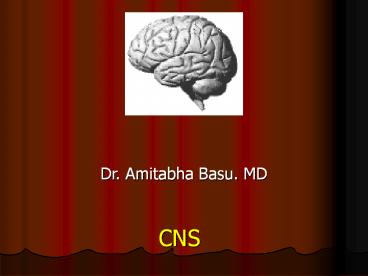CNS - PowerPoint PPT Presentation
Title: CNS
1
CNS
- Dr. Amitabha Basu. MD
2
(No Transcript)
3
Topic
- Edema of brain
- Herniation
- Hydrocephalous
- Vascular diseases
4
Edema
- Vasogenic edema Seen in case of abscess and
Neoplasm. - Fluid accumulate in the interstitial space.
- Cytotoxic Edema
- intracellular fluid accumulation due to Hypoxic
Cell Injury.
5
Edema complication
- Herniation of brain matter in severe case.
6
- Herniation
7
Herniation
- Etiology
- Due to mass effect.
- Tumor, Trauma( blood clot),
- Infection induced edema.
8
Types
- Transtentorial Herniation (uncal gyral )
- Subfalcine herniation (cingulate gyrus )
- Tonsillar Herniation
9
- Transtentorial Herniation Uncus
- Involved Brain Uncus medial portion of the
temporal lobe - Cause A Mass in the temporal area.
- Clinical effects
- Posterior cerebral artery compression Occipital
infarct. - Ipsilateral dilated pupil stretching of CN III
10
- Subfalcine Herniation
- (involve Cingulate gyrus )
11
Subfalcine herniation
Involved Brain cingulate gyrus Cause A Mass
in temporal/fontal(?) lobe Clinical effect
Anterior Cerebral Artery compression Weakness
and Sensory abnormality of the leg typically
occur with a Meningioma.
R
12
Tonsillar Herniation
- Herniation of the cerebellar tonsil through
foramen Magnum. - It is life threatening causes compression of
the vital respiratory center. - Complication Secondary Brain stem or Duret
hemorrhage.
13
Duret hemorrhage
- Kinking of the penetrating median and paramedian
pontine arteries a branch off the basilar
artery.
Pons
Spinal cord
14
Secondary Brain stem or Duret hemorrhage
- Causes
- Tonsillar Herniation
- Gliomas
15
- Hydrocephalus
The Thinker
16
Hydrocephalus
- Def Accumulation of excessive CSF within the
Ventricular System. - Etiology
- Decreased resorption of the CSF.
- Overproduction of CSF (in a choroid plexus
tumor-a papillary tumor in ventricle).
17
2 Types
- 1. Non communicating Hydrocephalous. Obstruction
within the ventricular system. - 2. Communicating Hydrocephalous. the obstruction
is in the subarachnoid space or venous sinuses.
18
Non communicating Hydrocephalous (0bstructive)
Cause
- Medulloblastoma,
- Ependymoma
No communication between ventricles and
subarachonoid space.
19
Communicating Hydrocephalous.
- Meningitis- adult.
- Subarachnoid hemorrhage- obstruction in
subarachnoid space (SAP)- adult
20
Hydrocephalous by meningitis
- Early acute phage obstruction of the SAP by
exudates. - Late chronic phage obstruction of the SAP by
fibrosis.
21
Morphology of hydrocephalous
- Infant Dilated ventricles, enlarged cranium
(increase Head circumference), atrophy of cortex
of brain. - Adult
- Dilated ventricle, Atrophy of cortex, enlargement
of cranium does not take place- dementia.
22
Child and adult
Sunset sign
23
Clinical features
- Infants young children
- Signs symptoms of increased ICP- irritability,
impaired conscious level, and vomiting. - Adult
- Early Signs symptoms of increased ICP- headache,
vomiting, papilledema and deteriorating conscious
level. - Late Dementia.
24
- Vascular Diseases
Persistence of the memory Salvador Dali
25
Vascular Diseases
- GENERAL FEATURES
- TYPES
- ETIOPATHOLOGY
- MORPHOLGY
- CLINICAL FEARYRES WITH INVESTIGATIONS.
26
RISK FACTORS OF ISCHEMIC BRAIN INJURY
- AGE
- DURATION OF THE HYPOXIA
- TEMPERATURE HYPOTHERMIA PROTECT HYPOXIC BRAIN
DAMAGE
27
Three categories'
- Global Hypoxic Ischemic Encephalopathy.
- Local infarct 80 of the total
- Hemorrhage.
28
A. Global Hypoxic Ischemic Encephalopathy.
- It occur when the systolic blood pressure goes
- below 50mmHg.
- Cause
- Cardiac arrest (due to myocardial infarct,
cardiac arrhythmias), - Aspiration of foreign objects, drowning.
- Early feature border zone infract
- Late features Laminar cortical necrosis
29
Border zone infarct Watershed infarct May
follows a Hypotensive episode.
Lesion lies at the boundary between the anterior
and middle cerebral artery territories.
30
Morphology Global Hypoxic Ischemic
Encephalopathy.
- Laminar cortical necrosis A LINEAR ZONE OF
SOFTENING DISCOLORATION IN THE CORTICAL MANTLE.
31
B. Infarct
- Caused by Local obstruction in blood vessels.
- Thromboembolism and other embolisms
- HAEMORRHAGE, Atheroma
- Hypertension
- Risk hypertension, smoking, diabetes mellitus.
- Most common form called Strokes.
- Age 7th Decades
- Sex Male gt Female.
32
Thrombo-embolism
- Most common in Middle cerebral Artery.
- Source of emboli
- Mural thrombus in the left ventricle of the
heart, - Atherosclerotic plaques involving more proximal
arteries (especially the carotid arteries).
33
Description of Morphological Changes of brain
infarct.
- Microscopical changes
- After 12 hours Red neuron and neutrophils
infiltration. - 36 to 48 hours Non-hemorrhagic or hemorrhagic
infarct (due to reperfusion). - By 10 days liquefaction occur presence of
macrophages and surrounding reactive gliosis. - 1 6 months a cystic cavity will form (remote
infarct).
34
Red neuron
Normal
Hemorrhagic infarct
35
Liquefactive necrosis
Tissue shows macrophage and microglial
proliferation in this time. CT shows enhancing
lesion.
36
Remote infarct ( cavity )
37
Remote infarct ( cavity )
- In the wall of the cavity shows reactive
astrocytes with reactive gliosis. - An CT would show enhancing shadow.
38
Shower embolizationMultiple small hemorrhage
fat embolism, amniotic fluid embolism
39
Lacunar infarcts
Hypertension induced infarct
Site The pons.
40
What are the signs infarction?
Clinical features
- TIA transient ischemic attack persists lt 24
hours. - Stroke gt24 hours
- Sudden numbness or weakness on one side of the
face, arm or leg . - Sudden trouble speaking or understanding.
- Sudden trouble seeing.
41
Clinical Features If middle cerebral Artery is
effected.
- Contralateral hemiparesis and spasticity.
- Visual Field abnormality
- In some case speech aphasia.
42
End of Stroke
Guernica

